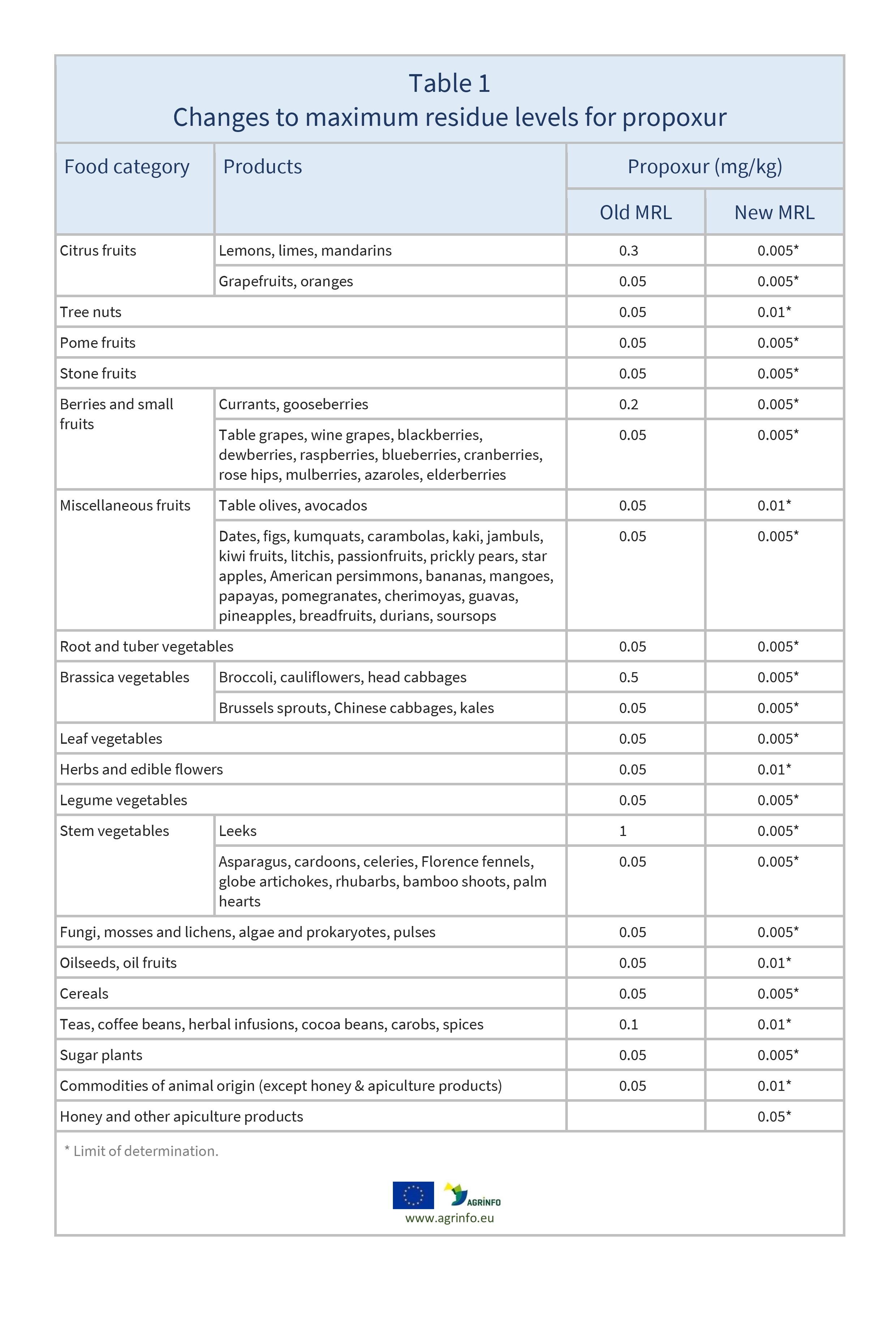Maximum residue levels for propoxur
- Pesticide MRLs
Summary
This Regulation reduces the maximum residue levels (MRLs) for propoxur to the limit of determination (0.005 to 0.01 mg/kg) on all products, withdrawing existing MRLs for lemons, limes, mandarins, currants, gooseberries, broccoli, cauliflowers, head cabbages, and leeks from February 2023. (The LOD is the lowest level that can be detected using the most modern and reliable analytical methods.)
EU reduces MRLs for propoxur to the limit of determination on all products, removing existing MRLs for certain fruits and vegetables from February 2023
Commission Regulation (EU) 2022/1406 of 3 August 2022 amending Annexes II, III and V to Regulation (EC) No 396/2005 of the European Parliament and of the Council as regards maximum residue levels for methoxyfenozide, propoxur, spinosad and thiram in or on certain products
Update
This Regulation reduces the maximum residue levels (MRLs) for propoxur to the limit of determination (0.005 to 0.01 mg/kg) on all products, withdrawing existing MRLs for lemons, limes, mandarins, currants, gooseberries, broccoli, cauliflowers, head cabbages, and leeks from February 2023. (The LOD is the lowest level that can be detected using the most modern and reliable analytical methods.)
Impacted Products
Lemons, limes, mandarins, currants, gooseberries, broccoli, cauliflowers, head cabbages, leeks
What is changing?
The MRLs for propoxur on all products are set at the LOD. This means significant changes for the products listed in Table 1, in particular.
In addition, the LOD is reduced on all other products (ranging from 0.005 to 0.01 mg/kg).
Why?
In a recent review, EFSA (2021) was unable to derive toxicological reference values for propoxur. The European Commission decided that in the absence of such data, risk to consumers cannot be excluded.
Timeline
New MRLs apply from 28 February 2023.
Products lawfully placed on the EU market in compliance with old MRLs before 28 February may remain on the market after that date, even where not compliant with the new MRLs.
Recommended Actions
Suppliers of lemons, limes, mandarins, currants, gooseberries, broccoli, cauliflowers, head cabbages, and leeks should seek alternative solutions to the use of propoxur on these products. Testing for levels below 0.01 mg/kg will affect how laboratories carry out pesticide residue analysis.
Background
MRLs are set in accordance with the rules set out in Regulation 396/2005. For information on current MRLs for other substances, please consult the EU Pesticide Residues database.
Resources
EFSA et al. (2021) Reasoned opinion on the toxicological properties and maximum residue levels for propoxur. EFSA Journal, 19(1): e06374.
Sources
Commission Regulation (EU) 2022/1406 as regards maximum residue levels for methoxyfenozide, propoxur, spinosad and thiram in or on certain products
Tables & Figures

Source: based on Commission Regulation 2022/1406
Disclaimer: Under no circumstances shall COLEAD be liable for any loss, damage, liability or expense incurred or suffered that is claimed to have resulted from the use of information available on this website or any link to external sites. The use of the website is at the user’s sole risk and responsibility. This information platform was created and maintained with the financial support of the European Union. Its contents do not, however, reflect the views of the European Union.
EU reduces MRLs for propoxur to the limit of determination on all products, removing existing MRLs for certain fruits and vegetables from February 2023
Commission Regulation (EU) 2022/1406 as regards maximum residue levels for methoxyfenozide, propoxur, spinosad and thiram in or on certain products
What is changing and why?
The maximum residue levels (MRLs) for propoxur on all products are now set at the limit of determination (LOD). (The LOD is the lowest level that can be detected using the most modern and reliable analytical methods.) This means significant changes for the products listed in Table 1, in particular.
The LOD is reduced on all products (ranging from 0.005 to 0.01 mg/kg) because risk to consumers cannot be excluded in the absence of toxicological reference data.
Actions
Suppliers should seek alternative solutions to the use of propoxur on all products. Testing for levels below 0.01 mg/kg will affect how laboratories carry out pesticide residue analysis.
Timeline
The new MRLs apply from 28 February 2023.
Products lawfully placed on the EU market in compliance with old MRLs before 28 February may remain on the market after that date, even where not compliant with the new MRLs.
Tables & Figures

Source: based on Commission Regulation 2022/1406
Disclaimer: Under no circumstances shall COLEAD be liable for any loss, damage, liability or expense incurred or suffered that is claimed to have resulted from the use of information available on this website or any link to external sites. The use of the website is at the user’s sole risk and responsibility. This information platform was created and maintained with the financial support of the European Union. Its contents do not, however, reflect the views of the European Union.
